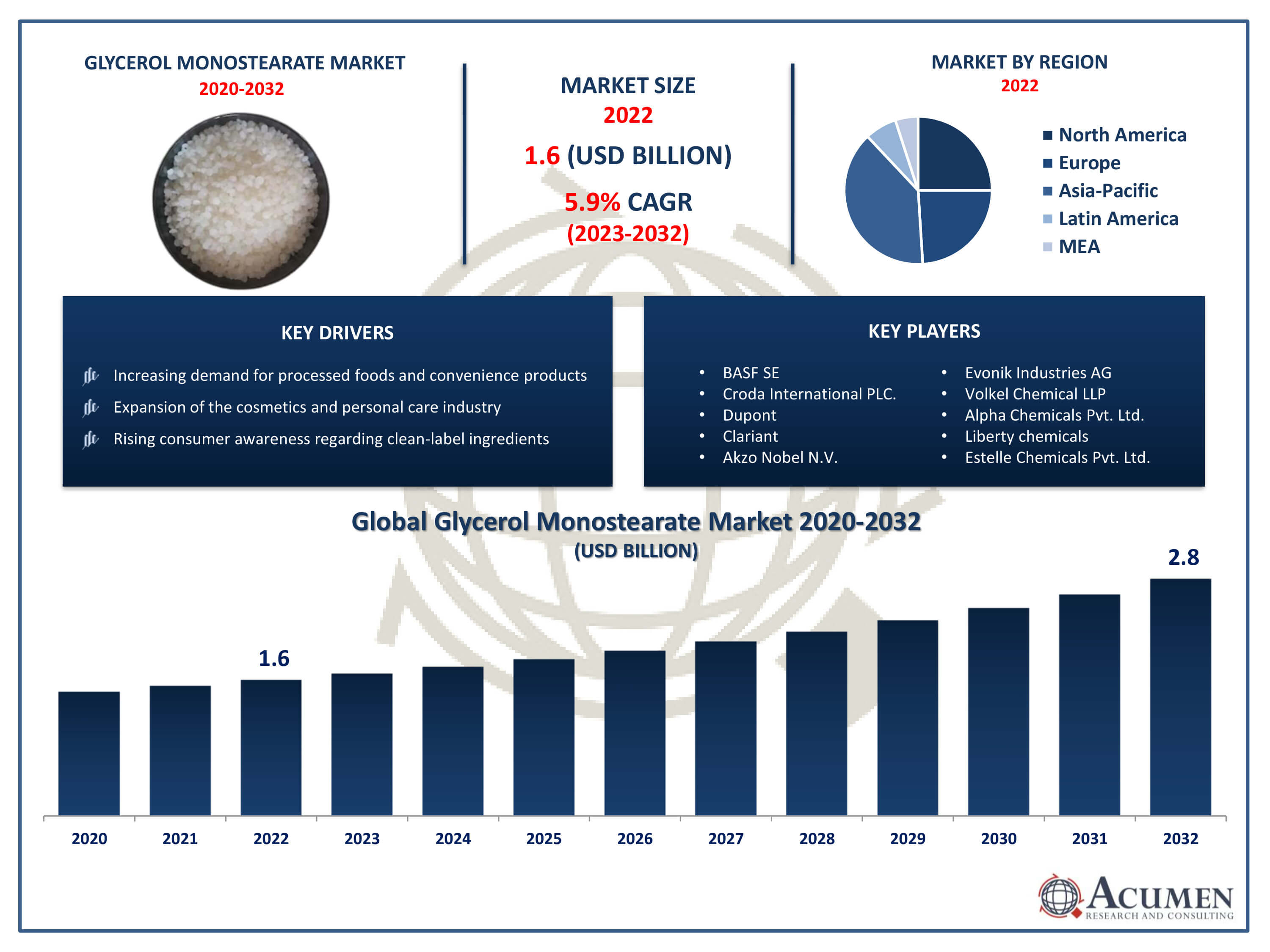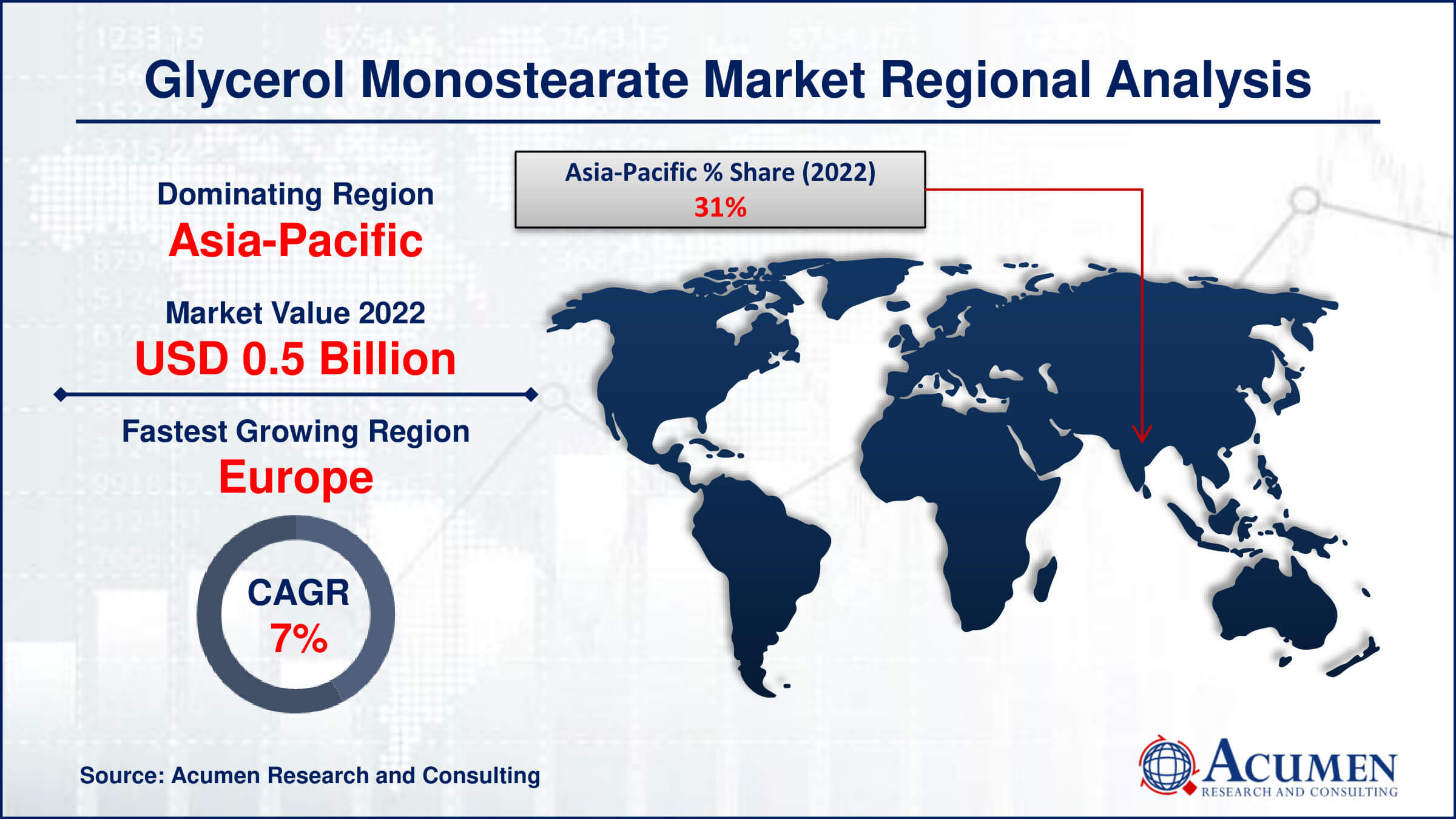March 2023
Glycerol Monostearate Market Size accounted for USD 1.6 Billion in 2022 and is projected to achieve a market size of USD 2.8 Billion by 2032 growing at a CAGR of 5.9% from 2023 to 2032.
The Glycerol Monostearate Market Size accounted for USD 1.6 Billion in 2022 and is projected to achieve a market size of USD 2.8 Billion by 2032 growing at a CAGR of 5.9% from 2023 to 2032.
Glycerol Monostearate Market Highlights

Glycerol monostearate (GMS) is a compound commonly used as an emulsifier, thickening agent, and stabilizer in various industries, including food, pharmaceuticals, and cosmetics. It is derived from natural fats, typically from vegetable oils or animal fats. GMS is produced by the esterification of glycerol with stearic acid, resulting in a versatile compound with diverse applications.
In the food industry, glycerol monostearate is widely employed as an emulsifier in baked goods, dairy products, confectionery, and processed foods to improve texture, consistency, and shelf life. Additionally, it is utilized as a thickening agent in ice creams and whipped toppings. In pharmaceuticals, GMS serves as an excipient in formulations to enhance the stability and dispersibility of active ingredients in medications. Moreover, GMS finds applications in cosmetics and personal care products, acting as an emollient and emulsifier in creams, lotions, and makeup items. The market for glycerol monostearate has witnessed steady growth over the past few years, driven by the increasing demand for processed foods, convenience products, and pharmaceutical formulations.
Global Glycerol Monostearate Market Trends
Market Drivers
Market Restraints
Market Opportunities
Glycerol Monostearate Market Report Coverage
| Market | Glycerol Monostearate Market |
| Glycerol Monostearate Market Size 2022 | USD 1.6 Billion |
| Glycerol Monostearate Market Forecast 2032 |
USD 2.8 Billion |
| Glycerol Monostearate Market CAGR During 2023 - 2032 | 5.9% |
| Glycerol Monostearate Market Analysis Period | 2020 - 2032 |
| Glycerol Monostearate Market Base Year |
2022 |
| Glycerol Monostearate Market Forecast Data | 2023 - 2032 |
| Segments Covered | By Purity, By Application, By End-use, And By Geography |
| Regional Scope | North America, Europe, Asia Pacific, Latin America, and Middle East & Africa |
| Key Companies Profiled | BASF SE, Croda International PLC., Dupont, Clariant, Akzo Nobel N.V., Evonik Industries AG, Volkel Chemical LLP, ACM chemicals, Alpha Chemicals Pvt. Ltd., Liberty chemicals, Estelle Chemicals Pvt. Ltd., and A. Schulman Inc. |
| Report Coverage |
Market Trends, Drivers, Restraints, Competitive Analysis, Player Profiling, Covid-19 Analysis, Regulation Analysis |
Glycerol monostearate (GMS) is a compound widely used across various industries, including food, pharmaceuticals, and cosmetics. It is a fatty acid ester derived from natural sources such as vegetable oils or animal fats. GMS is produced through the esterification of glycerol with stearic acid, resulting in a versatile compound with unique properties. One of its primary functions is as an emulsifier, aiding in the formation and stabilization of emulsions by reducing the surface tension between two immiscible phases, such as oil and water. In the food industry, glycerol monostearate serves multiple purposes. It acts as an emulsifier in baked goods, dairy products, confectionery, and processed foods, improving texture, consistency, and shelf life. Additionally, GMS is utilized as a thickening agent in ice creams, whipped toppings, and other desserts. In pharmaceutical formulations, glycerol monostearate functions as an excipient, enhancing the stability and dispersibility of active ingredients in medications.
The market for glycerol monostearate (GMS) has been experiencing robust growth over the past few years and is expected to continue expanding steadily. GMS serves as a key ingredient in various industries, including food, pharmaceuticals, and cosmetics, due to its versatility as an emulsifier, thickening agent, and stabilizer. The increasing demand for processed foods, convenience products, and pharmaceutical formulations has been a significant driver for the growth of the GMS market. As consumers seek products with improved texture, stability, and shelf life, manufacturers are turning to GMS to meet these demands effectively. Moreover, the rising consumer awareness regarding clean-label and natural ingredients has fueled the adoption of GMS derived from vegetable sources, further boosting market growth. Manufacturers are also investing in research and development to enhance the functionality of glycerol monostearate and develop innovative formulations for specialty food and pharmaceutical applications. Additionally, the expansion of the cosmetics and personal care industry, particularly in emerging markets, presents lucrative opportunities for GMS manufacturers to diversify their product portfolios and penetrate new market segments.
Glycerol Monostearate Market Segmentation
The global glycerol monostearate market segmentation is based on purity, application, end-use, and geography.
Glycerol Monostearate Market By Purity
According to the glycerol monostearate industry analysis, the <90% segment accounted for the largest market share in 2022. One significant driver is the burgeoning demand for clean-label and natural ingredients across various industries, including food, pharmaceuticals, and cosmetics. As consumers become increasingly conscious of the ingredients in the products they consume and use, there has been a notable shift towards GMS derived from vegetable sources, which has fueled segment growth substantially. This preference for natural emulsifiers and stabilizers has propelled manufacturers to innovate and develop new formulations to meet the evolving needs of consumers. Furthermore, the rapid expansion of the processed food industry globally has contributed significantly to the remarkable segment growth in the glycerol monostearate market. With the growing demand for convenience foods, baked goods, dairy products, and confectionery items, manufacturers are increasingly incorporating GMS into their formulations to enhance texture, consistency, and shelf life.
Glycerol Monostearate Market By Application
In terms of applications, the emulsifier segment is expected to witness significant growth in the coming years. This surge can be attributed to several key factors driving the demand for emulsifiers in various industries. One significant factor is the rising consumer preference for processed foods, bakery products, and convenience items, which necessitate stable emulsions for optimal texture and shelf life. GMS, with its emulsifying properties, has emerged as a preferred choice for manufacturers seeking to enhance the quality and appeal of their products. Moreover, the growing awareness among consumers about the health and environmental implications of synthetic additives has prompted the food industry to seek natural alternatives like GMS. Derived from vegetable sources, GMS aligns with clean-label trends, contributing to its rapid adoption as an emulsifier. Additionally, the pharmaceutical and cosmetic sectors have also witnessed a surge in demand for emulsifiers like GMS, driven by the need for stable formulations and improved product efficacy.
Glycerol Monostearate Market By End-use
According to the glycerol monostearate market forecast, the food & beverages segment is expected to witness significant growth in the coming years. One primary driver is the increasing consumption of processed foods and convenience items worldwide. GMS is widely utilized in this sector as an emulsifier, stabilizer, and thickening agent to improve texture, consistency, and shelf life. Its versatility and effectiveness in enhancing product quality have made it a staple ingredient in a wide range of food and beverage products, including baked goods, dairy items, confectionery, and ready-to-eat meals. Moreover, the rising demand for clean-label and natural ingredients has further propelled the growth of GMS in the food and beverages segment. Consumers are increasingly seeking products with recognizable and natural ingredients, prompting manufacturers to replace synthetic additives with natural alternatives like GMS derived from vegetable sources. This trend aligns with the industry's efforts to cater to health-conscious consumers and meet regulatory standards for food safety and ingredient transparency.
Glycerol Monostearate Market Regional Outlook
North America
Europe
Asia-Pacific
Latin America
The Middle East & Africa

Glycerol Monostearate Market Regional Analysis
The Asia-Pacific region has emerged as the dominating force in the glycerol monostearate (GMS) market, owing to several factors contributing to its rapid growth and expansion. One key driver is the region's burgeoning population, coupled with increasing urbanization and rising disposable incomes. This demographic shift has led to a surge in demand for processed foods, cosmetics, and pharmaceuticals, all of which are major end-users of GMS. As a result, manufacturers in the Asia-Pacific region are ramping up production to meet the escalating demand, thereby driving market growth. Furthermore, the region's robust manufacturing capabilities and competitive production costs have positioned it as a preferred destination for GMS production. Countries like China, India, and Indonesia boast significant manufacturing capacities for GMS, supported by a well-established supply chain and infrastructure. Additionally, the presence of a large number of multinational corporations and local players in the food, pharmaceutical, and cosmetics industries further stimulates market growth in the Asia-Pacific region. These companies leverage the region's favorable business environment, skilled workforce, and strategic partnerships to expand their presence and capture market share in the glycerol monostearate market.
Glycerol Monostearate Market Player
Some of the top glycerol monostearate market companies offered in the professional report include BASF SE, Croda International PLC., Dupont, Clariant, Akzo Nobel N.V., Evonik Industries AG, Volkel Chemical LLP, ACM chemicals, Alpha Chemicals Pvt. Ltd., Liberty chemicals, Estelle Chemicals Pvt. Ltd., and A. Schulman Inc.
Looking for discounts, bulk pricing, or custom solutions? Contact us today at sales@acumenresearchandconsulting.com
March 2023
November 2022
November 2024
March 2023